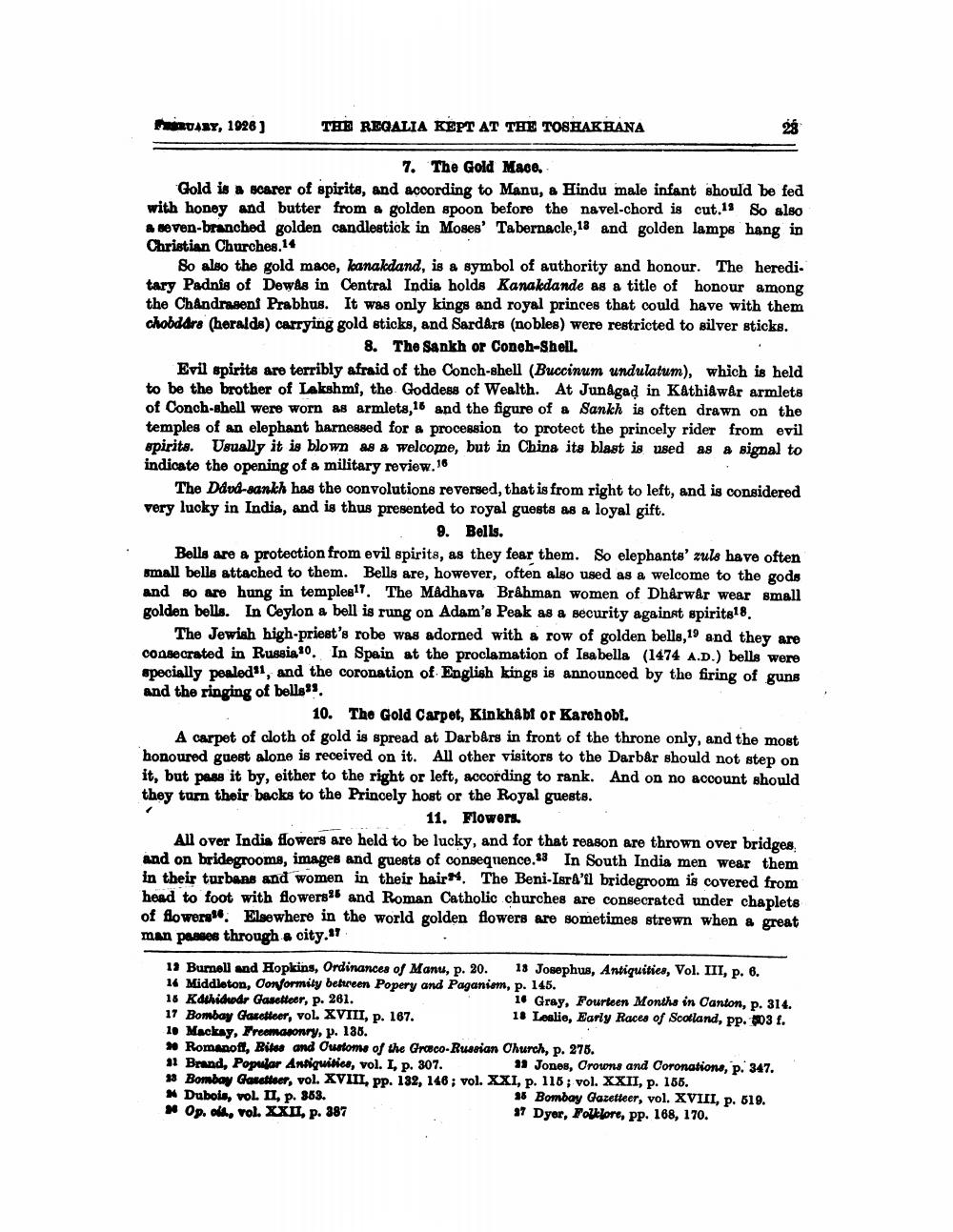________________
RUASY, 1926 )
THE REGALIA KÉPT AT THE TOSHAKHANA
7. The Gold Mace. Gold is a scarer of spirits, and according to Manu, a Hindu male infant should be fed with honey and butter from a golden spoon before the navel-chord is cut.13 So also
leven-branched golden candlestick in Moses' Tabernacle, 18 and golden lampe hang in Christian Churches.14
So also the gold mace, lanakdand, is a symbol of authority and honour. The heredi. tary Padnis of DewAs in Central India holds Kanakdande as a title of honour among the Chandraseni Prabhus. It was only kings and royal princes that could have with them chobddrs (heralda) carrying gold sticks, and Sardars (no bles) were restricted to silver sticks.
8. The Sankh or Conch-Shell. Evil spirits are terribly afraid of the Conch-shell (Buccinum undulatum), which is held to be the brother of Lakshmi, the Goddess of Wealth. At Junagad in Kathidwar armlets of Conch-shell were worn as armlets, 16 and the figure of a Sankh is often drawn on the temples of an elephant barnessed for a procession to protect the princely rider from evil spirits. Usually it is blown as a welcome, but in China its blast is used as a signal to indicate the opening of a military review.10
The Dand-aankh has the convolutions reversed, that is from right to left, and is considered very lucky in India, and is thus presented to royal guests as a loyal gift.
9. Bells. Bells are & protection from evil spirits, as they fear them. So elephants' zuls have often small bells attached to them. Bells are, however, often also used as a welcome to the gods and 80 are hung in temples17. The Madhava Brahman women of Dharwar wear small golden bells. In Ceylon a bell is rung on Adam's Peak as a security against spirits18.
The Jewish high-priest's robe was adorned with a row of golden bells,19 and they are Consecrated in Russiało. In Spain at the proclamation of Isabella (1474 A.D.) bells were specially pealeds, and the coronation of English kings is announced by the firing of guns and the ringing of bells".
10. The Gold Carpet, Kinkhabi or Kareh obl. A carpet of cloth of gold is spread at Darbårs in front of the throne only, and the most honoured guest alone is received on it. All other visitors to the Darbar should not step on it, but pass it by, either to the right or left, according to rank. And on no account should they turn their backs to the Princely host or the Royal guests.
11. Flowers. All over India flowers are held to be lucky, and for that reason are thrown over bridges, and on bridegrooms, images and guests of consequence.83 In South India men wear them in their turbans and women in their hair. The Beni-Isra'il bridegroom is covered from head to foot with flowers 25 and Roman Catholic churches are consecrated under chaplets of flowerg. Elsewhere in the world golden flowers are sometimes strewn when a great man passes through a city.17
11 Bumell and Hopkins, Ordinances of Manu, p. 20. 18 Josephus, Antiquities, Vol. III, p. 6. 14 Middleton, Oonformity between Popery and Paganiem, p. 145. 16 Kathidhdr Gasoleer, p. 261.
16 Gray, Fourteen Months in Canton, p. 314. 17 Bombay Gazetteer, vol. XVIII, p. 167.
18 Leslio, Early Races of Scotland, pp. 303 f. 1o Mackay, Freemasonry, p. 188. > Romanoft, Rites and Customs of the Greco-Russian Church, p. 278. 1 Brand, Popular Antiquitics, vol. I, p. 307.
11 Jones, Orowns and Coronations, p. 347. 13 Bombay Ganetteer, vol. XVIII, pp. 132, 146; vol. XXI, p. 116; vol. XXII, p. 156. * Dubois, vol II, p. 363.
35 Bombay Gazetteer, vol. XVIII, p. 619. * Op. cit., vol. XXII, p. 387
37 Dyer, Folklore, pp. 168, 170.




